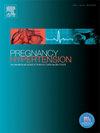Validation of the fullPIERS model in a tertiary hospital in southern Brazil
IF 2.9
4区 医学
Q2 OBSTETRICS & GYNECOLOGY
Pregnancy Hypertension-An International Journal of Womens Cardiovascular Health
Pub Date : 2025-07-01
DOI:10.1016/j.preghy.2025.101237
引用次数: 0
Abstract
Objective
To validate the fullPIERS model’s efficacy in predicting adverse maternal and neonatal outcomes in women with preeclampsia at a tertiary teaching hospital in southern Brazil.
Methods
This retrospective study analyzed data from women diagnosed with preeclampsia at the Hospital de Clínicas de Porto Alegre (HCPA) between January 2017 and August 2024. Patient data extracted from hospital records was used to calculate the fullPIERS score. Adverse maternal outcomes, including HELLP syndrome, placental abruption and pulmonary edema, were assessed within 48 h and 7 days post-admission, as well as adverse neonatal outcomes. Model performance was assessed by calculating the area under the curve (AUC) from ROC analysis, and the optimal threshold for predicting adverse maternal outcomes was determined.
Results
A total of 665 women with preeclampsia were included in the study, of whom 124 (18.6 %) experienced adverse maternal outcomes. The median fullPIERS was higher among women with maternal complications (1.55 % [IQR 0.55–5.9] vs. (0.6 % [IQR 0.3–1.2]; p < 0.001). The fullPIERS model demonstrated acceptable accuracy for predicting adverse maternal outcomes (AUC = 0.721, CI 0.652 – 0.790, p-value < 0.01). A threshold of 2.26 % yielded the best predictive performance, with an accuracy of 70.26 %, sensitivity of 51.1 % and specificity of 89.4 %. FullPIERS also showed a moderate performance in predicting adverse neonatal outcome (AUC = 0.736, 95 % CI 0.686–0.786, p < 0.001) and for combined maternal and neonatal outcomes (AUC = 0.742, 95 % CI 0.689–0.785, p < 0.001).
Conclusion
The fullPIERS model is a reliable tool for predicting adverse maternal and neonatal outcomes; however, its performance appears suboptimal compared to data from high-income countries.

fullPIERS模型在巴西南部三级医院的验证
目的验证巴西南部某三级教学医院的fullPIERS模型在预测子痫前期产妇和新生儿不良结局方面的有效性。方法本回顾性研究分析了2017年1月至2024年8月期间在阿雷格里港医院(Clínicas de Porto Alegre, HCPA)诊断为子痫前期妇女的数据。从医院记录中提取的患者数据用于计算fullPIERS评分。在入院后48小时和7天内评估产妇不良结局,包括HELLP综合征、胎盘早剥和肺水肿,以及新生儿不良结局。通过计算ROC分析的曲线下面积(AUC)来评估模型的性能,并确定预测不良产妇结局的最佳阈值。结果本研究共纳入665例先兆子痫妇女,其中124例(18.6%)出现不良孕产结局。有母体并发症的女性中位fullPIERS更高(1.55% [IQR 0.55-5.9] vs. 0.6% [IQR 0.3-1.2];p & lt;0.001)。fullPIERS模型在预测产妇不良结局方面显示出可接受的准确性(AUC = 0.721, CI 0.652 - 0.790, p值<;0.01)。阈值为2.26%,预测准确率为70.26%,敏感性为51.1%,特异性为89.4%。FullPIERS在预测新生儿不良结局方面也表现中等(AUC = 0.736, 95% CI 0.686-0.786, p <;0.001)以及母婴合并结局(AUC = 0.742, 95% CI 0.689-0.785, p <;0.001)。结论:fullPIERS模型是预测孕产妇和新生儿不良结局的可靠工具;然而,与高收入国家的数据相比,中国的表现似乎并不理想。
本文章由计算机程序翻译,如有差异,请以英文原文为准。
求助全文
约1分钟内获得全文
求助全文
来源期刊

Pregnancy Hypertension-An International Journal of Womens Cardiovascular Health
OBSTETRICS & GYNECOLOGYPERIPHERAL VASCULAR-PERIPHERAL VASCULAR DISEASE
CiteScore
4.90
自引率
0.00%
发文量
127
期刊介绍:
Pregnancy Hypertension: An International Journal of Women''s Cardiovascular Health aims to stimulate research in the field of hypertension in pregnancy, disseminate the useful results of such research, and advance education in the field.
We publish articles pertaining to human and animal blood pressure during gestation, hypertension during gestation including physiology of circulatory control, pathophysiology, methodology, therapy or any other material relevant to the relationship between elevated blood pressure and pregnancy. The subtitle reflects the wider aspects of studying hypertension in pregnancy thus we also publish articles on in utero programming, nutrition, long term effects of hypertension in pregnancy on cardiovascular health and other research that helps our understanding of the etiology or consequences of hypertension in pregnancy. Case reports are not published unless of exceptional/outstanding importance to the field.
 求助内容:
求助内容: 应助结果提醒方式:
应助结果提醒方式:


